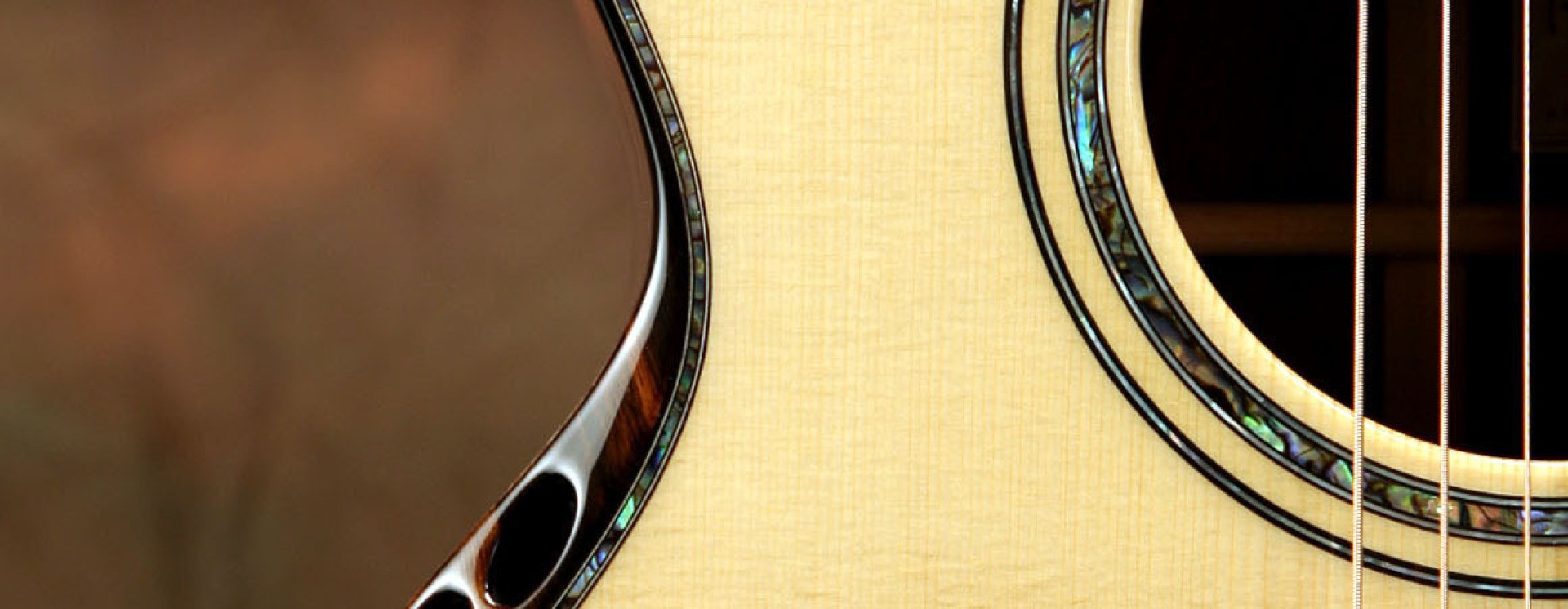HORIZONTAL CD
8 Songs, 45 Minutes
Released: Jan 22, 2014
© 2019/2020 MüktiMusic Ascap
℗ 2019/2020 Light Without Heat (Steve Vai)
https://music.apple.com/album/1457886447?app=itunes&ls=1
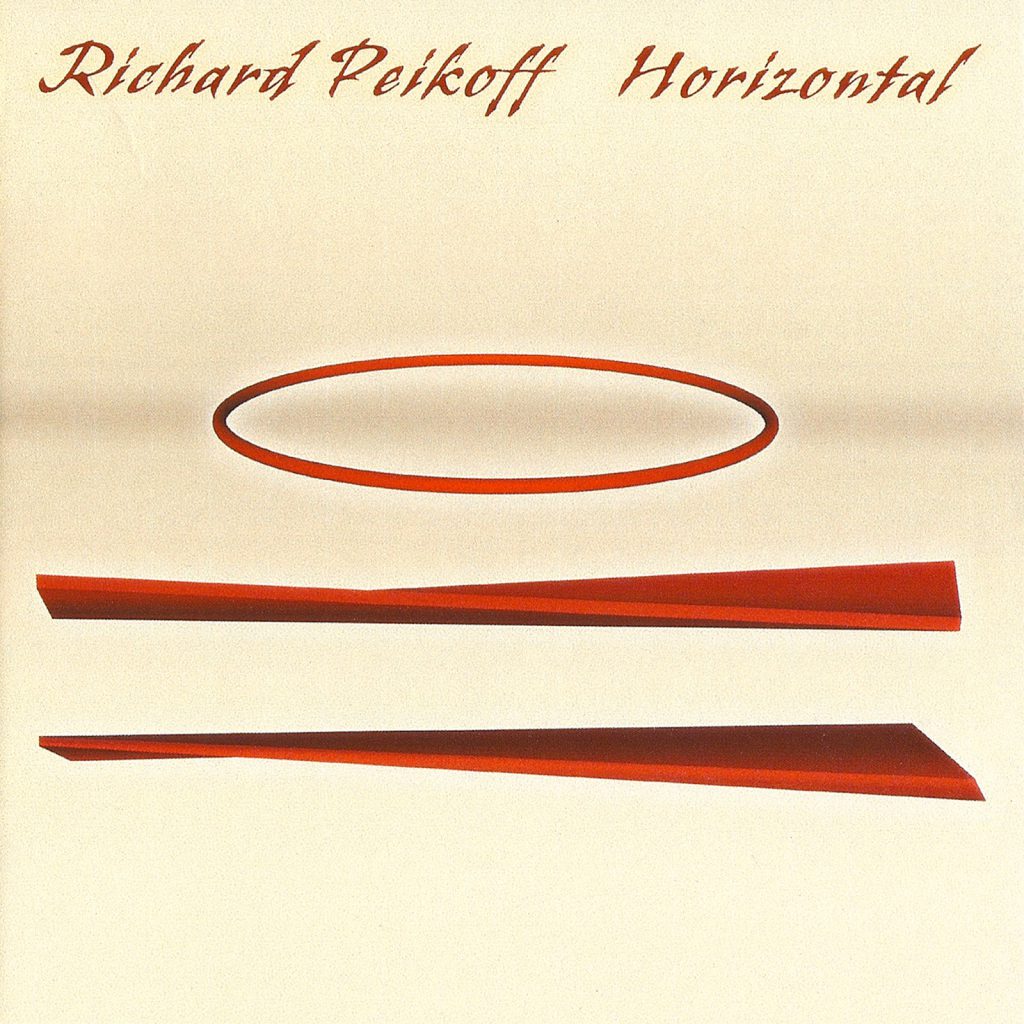
Richard Peikoff : Acoustic FingerStyle Guitar, Slide Guitar, Composer, Co-Producer
Jeff Miley: Acoustic Guitar
Clifford Novey: Co Producer, Recordist, CoWriter (Epilogue), Cover Art
Greg Back: Recordist
Steve Vai: Executive Producer
Jeroen Noordhuis: WebMaster
Much credit goes to Co-Producer Clifford Novey for saving this recording which is one of my favorite albums. Clifford is a a bit of a genius and though relatively new to his engineering skills at the time, he was more than capable of reconstructing the original recording which had no shortage of potholes. At times Miley’s tracks sounded like they were recorded in another room! And though I credit Greg Back for originally tracking the duet, it was Novey who breathed life into the album.
Jeff Miley has been one of my all-time favorite guitar colleagues to record with. He has a style that ranges from pure consonance (Mirrors and Pilgrim) to a much darker side as evidenced in Baquista & Ram Narayan, See more below. It is pretty easy to differentiate our two styles. As the composer, my FingerStyle approach covers a lot of ground as regards the basic rhythm of the track as well as complex somewhat left of center melodies at times, all played within a solo guitar structure. By having someone such as Jeff conversing with that, you start to approach the description: 2 guitars can be an orchestra!
1) Déjà Vu rT 0:57

Déjà Vu is a short excerpt from the concluding track Epilogue, which along with Ram Narayan represents the Eastern Suite for this recording. So in a sense, it’s an inverted déjà vu presented before a déjà vu would normally take place! Does that make sense? Now I’m confused: I think I am experiencing a déjà vu just in the attempt to explain! Yikes. It’s like I’ve been here before. Haha! Regardless the short intro contains some of the natural sounds used for the background of Epilogue: birds, Australian frogs, cicadas, dripping water. I promise you by the time you listen to Epilogue, you will be experiencing an authentic déjà vu. Anyway, let us proceed forward, shall we? Didn’t I already ask that question? Is there an echo in
here?!?!?!
2) Pilgrim rT 5:42

Jeff Miley, as mentioned in the opening statement, offers a significant amount of character to this album beginning with this piece, ‘Pilgrim’. The original arrangement is part of the VG-8 album which is entirely solo. Here, as is true for 5 of the 8 tracks on Horizontal, Miley is front and center both during the duet ensemble and the individual solos. For the most part on this piece, my fingerstyle work is stereo and shelved to the left and center. Jeff can be heard center and just to the right of center. I play without picks, Jeff uses a pick even on a nylon string.
Pilgrim is an upbeat beat, confident, and spiritual composition filled with much consonant musical conversation: melodies being expressed by both of us: plenty of harmonics and bass pedal tones along with the basic structure of the composition: two distinct solo sections (relatively short compared to other duets in the discography, including elsewhere on this album). While Jeff is tuned to Standard Tuning (ST), I am as usual in an opening tuning, usually Dadgad or a Dadgad variation (this facilitates my slide guitar approach to single-line work).
The tuning of my guitar on this piece is CADEAD which can be viewed primarily in two ways: either as a CM6/9 tuning with the root in the bass; or an A Minor4 tuning with the minor 3rd in the bass. The second perspective is what is conveyed in this musical conversation, as the piece lends itself to an A Minor tonal center.
The piece begins in 6/4 as the arpeggiated rolls are introduced, and shifts into 4/4 when the main theme is introduced in Section B. The 4/4 carries through to Section C with an ascending bass figure on my guitar along with harmonics. Finally, just before the solo sections, there is a lovely transition with Jeff soloing and my guitar moving to and fro between FingerStyle and harmonic themes before I contribute a short solo with slide and harmonics.
The structure returns again to a turnaround (previously stated): then back to the theme. At the conclusion, the piece returns to the original arpeggiated section, with increased dynamics, and a final fixed ending (no fade).
3) Mirrors rT 4:08

Mirrors is another beautiful contribution to consonant duet guitar work. I would say the genre skates a somewhat (‘Musical TriState Sensibility’) bordering on Folk, Jazz, and New Age. Section A & B clearly state the theme originally composed by me using a FingerStyle approach to a Dadgad variation: CGCFGC, which is the equivalent of Dadgad tuned 1 whole step lower. Dadgad is easy to pronounce: Dad Gad. In the previous piece: Pilgrim, one can also pronounce the tuning phonetically and call it: Cad-EE-Add. However, CGCFGC tuning is a bit trickier. I refer to it as Sa Gik Fa Gik Tuning!
There is a nice Section C which sets the composition heading back to sections A & B and is also elaborated on by Jeff with some very tasty chromaticism. The piece wraps up with Section D which is an extended Ride Out with some complex harp-like fingerstyle arpeggios and bass lines (Pierre Bensusan would be proud of me!) along with Jeff’s single line work. Again the piece comes to a full stop on a single harmonic note.
I feel in order to play a piece such as ‘Mirrors’, there has to be a deep understanding of the friendship that acoustic playing requires. There really is no ‘jamming’ on top of the other guitarist at anytime. The conversation always conveys a sense of deep listening, respect; and honors the path of mastery: which is always a process, and not a destination (at least in imho).
4) Soft Clocks rT 7:20
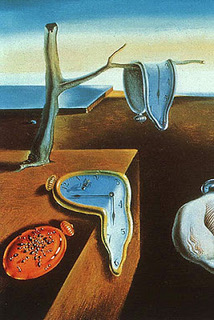
Soft Clocks which is also heard solo on the VG-8 Synth Guitar Live album; is here presented in a definitive tour de force duet with Jeff Miley doubling the FingerStyle themes with his signature single line work in unison and also octave work. Miley also inserts an abundant use of chromaticism in his inimitable way, This is a ‘Complex’ piece that combines beautiful consonance and dissonance in the field of a Phrygian Harmonic structure. This piece has an interesting arrangement. 4/4, 5/4, and 6/4 time signatures are used seamlessly throughout. I think this is cool, My odd time signature use is more influenced by my study of East Indian music than any other style.
The piece begins with a sense of urgency that continues throughout even though there is a cut-time sensibility in the 5/4 section which is one of my favorite handoffs of duets on this album or any of the 9 albums of my discography. Although I use the term (‘cut-time sensibility’) Cut-Time is usually reserved for a 2/4 meter. Here I am stealing from that principle because the rhythm grooves are slowed down, and yet the solos are taking place over the odd time signature of 5/4. So please consider the reference as figurative rather than literal.
My tuning on this piece is a Phrygian tuning: DGDGAbD which is a Gb2 tuning with no 3rd. Three scales or modes are used throughout, not including Miley’s chromatic treatments. As mentioned earlier in the notes for the VG-8 project, the 3 phrygian mediums are:
G Phrygian: GAbBbCDEbFG (Key of Eb rotated)
G Phrygian Dominant: GAbBCDEbFG (C Harmonic Minor rotated
G Phrygian Octatonic: GAbBbBCDEbFG which is a combination of the two 7-tome scales/modes to create an 8-tone scale.
5) Horizontal rT 4:52

The image above for the title track Horizontal is the i-Ching Hexagram (2 of 64 hexagrams) for ‘Earth’ or the Creative Principle (Receptive) called K’un. Think Mother Earth where all is manifest and birth takes place. Hexagram 1of 64 of the i-Ching hexagrams (Ch’ien) which is 6 unbroken lines is the hexagram for ‘Heaven or Force: (may the Force be with you!).
I decided to perform this piece solo as it is an intimate revelation of not only my musical compositional thinking, but also my spiritual principles, which on a good day are those of a Vertical Being: whose thoughts, words, and deeds are all in alignment. The inverse of that would be a Crooked Being, who thinks one way, speaks another, & yet acts a third way. I have been guilty of this at times, Please feel free to hurl the 1st stone if you like 🙂 Lately, however, I am more like the Leaning Tower of Pisa. Almost vertical!!
Horizontal is somewhat rubato (without tempo) in many ways. Nevertheless, there are a plethora of themes, licks, motifs, and pure scale movements that take on tempos of their own. If I remember correctly, and I would have to go back and review my notes, there are approximately 6-8 different exotic Scales & Modes used in this piece. All the single line work is arpeggiated in a harp-like fashion (investigate the work of Pierre Bensusan). The open tuning used is Dadgad, which as far as Tunings go is my ‘Main Squeeze’! My man!!
This track is mysterious, yet very open, Imho it is purely inclusive, not exclusive. Even though there is much dissonance throughout, but there is also much consonance. As regards the hexagram K’un, this composition, though at times forceful, is simultaneously receptive. For me, it is a romantic balance of Heaven (Yang: pronounced phonetically as Yawn) and Earth (Yin).
This title track of the album Horizontal is no doubt the most complex composition that I’ve ever written. There is no improvisation in the piece, It is completely ‘written’ or composed. I hope that you will listen to it a few times in a row and catch the spirit of true love in the music and the performance.
Baraka Sasa (Blessings Now!) Swahili.
6) Baquista rT 8:20
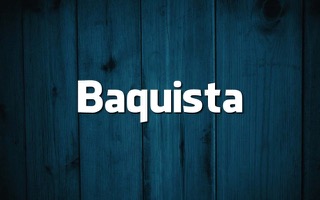
Baquista is a mysterious and somewhat sad piece with dark coloring and is emotionally intense. I entitled this piece and dedicated it to a beautiful dog named Baquista that belonged to a friend of mine in Marin County: Georgia Ortega (an enlightened woman, terrific dancer, and choreographer). I wrote the piece in the days just after Baquista died. This is another piece that employs odd time signatures. There’s a cool figure that is plucked double stops that sweep in from the 2 outer strings to the two inner strings and then back. The time signature is 2 bars of 4 and a bar of 11 for a total of 19/4.
Jeff takes a dissonant solo across yet another odd time signature of 10/4 following a lengthy section of 4/4. The piece is unsettling as I view it today. But I was moved to write it and I am glad that I included it on this album. It is in many ways the most unusual composition I’ve written, definitely left of left, yet it offers some guitar harmonies not usually heard. It begins with a slide introduction and Jeff’s chromaticism permeates throughout.
7) Ram Narayan rT 7:10
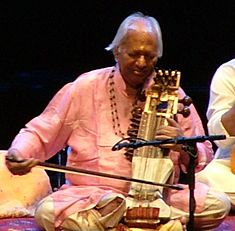
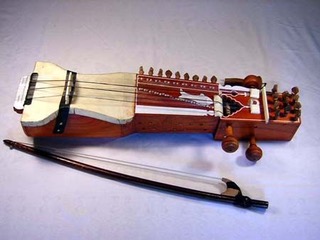
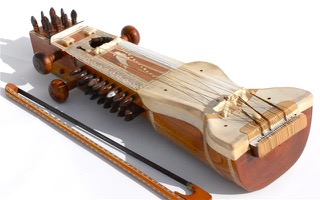
Pandit Ram Narayan (age 91) is an Indian musician who popularized the bowed instrument sarangi as a solo concert instrument in Hindustani classical music and became the first internationally successful sarangi player. The fingers of the left hand are used for stopping the strings with the sides of the fingernails, not with the balls of the fingers. The bow is held palm upwards and is drawn across the main strings, just above the bridge. The sarangi is considered to be the most difficult of all the East Indian string instruments to play.
When I returned from India, where I was playing 10-14 hours daily for 3 months (see the notes for the album Monsoon Season) I ended up in Mill Valley, CA which is very near Sausalito and just across the Golden Gate Bridge from San Francisco. See the continuing story included in the category Personal History, which elaborates in-depth several life stories that are not in the Bio category. Upon returning the West I continued to practice daily upwards to 10 hours as I was still on fire from the experience in India. I composed several compositions that are included in the complete discography including the compositions: Upside Down, Bach’s Lunch, Trek, Goodbye Magritte, Sweet & Sour City, Lake Country, and this piece entitled Ram Narayan, inspired by the sarangi master: Pandit Ram Narayan (Born December 25, 1927, in Mewar, Rajasthan, India).
The two compositions that conclude this album are considered an Eastern Suite, I studied Pandit Ram Narayan’s music daily, playing slide guitar along with his sarangi albums, and diving into some very eclectic ragas that utilized scales and modes that were new to me, but soon became harmonic destinations that I thoroughly enjoyed visiting.
Jeff Miley does a spectacular job both rhythmically and especially during his solos, of capturing the sweet spots that the Pandit was touching on in my studies; and which later inspired this composition. In the co-writing of the accompanying piece Epilogue, which completes the Eastern Suite of this album, I worked with co-producer Clifford Novey to create a synthetic ensemble (midi, loops, samples, and reverse slide guitar). One of the components of that ensemble is the 4 chords that I am emphasizing in this piece or tribute to the sarangi master. Therefore I could not think of a better title than to name it Ram Narayan!
Below are photos of this lap held, cello-like instrument, the sarangi. Also I’ve included a photo of master: Pandit Ram Narayan.
8) Epilogue rT 7:21

Epilogue completes the Eastern Suite of the Horizontal album, and along with Ram Narayan accounts for approximately 1/3 of the entire recording. What I refer to as the Synthetic Ensemble is a combination of samples, loops, reverse slide guitar, and previously recorded performances. Members of the MIDI Ensemble include (in order of appearance):
Tambura: 2 Players (Recorded & Looped).
1 small high-pitched Japanese bowl-shaped bell modulated low.
Rhythm Guitar Loops from Ram Narayan (4 Critical Chords in 2/4).
Cicadas (Sampled).
Australian Frogs (Sampled).
Birds (Sampled).
Reverse Slide Guitar Motif : (also from Ram Narayan & panned left to right & then right to left).
Same small high pitched Japanese bowl-shaped bell modulated high.
Reverse Slide Guitar Motif : (also from Ram Narayan & panned left to right & then right to left).
Dripping Water (recorded by wringing a wet rag into a bowl).
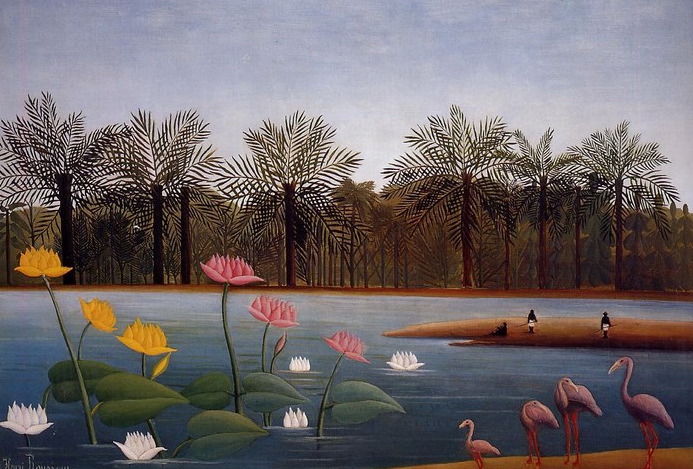
HENRI ROUSSEAU :: FLAMINGOS
